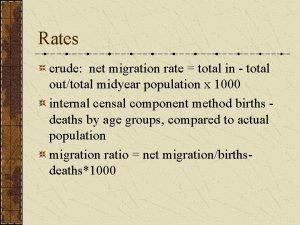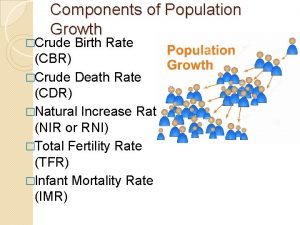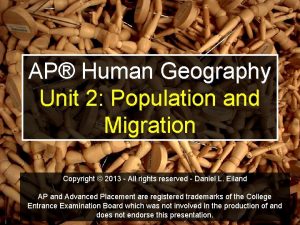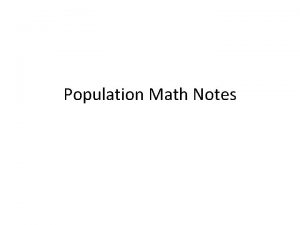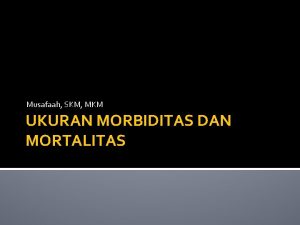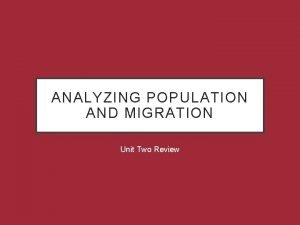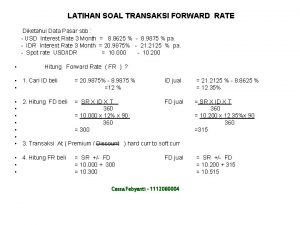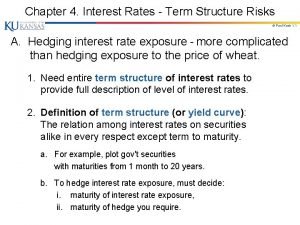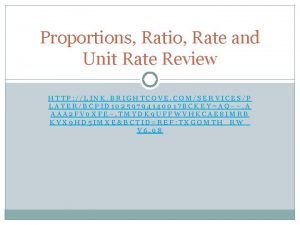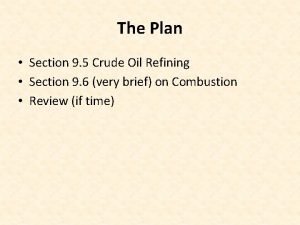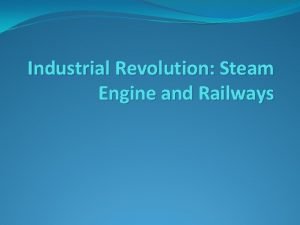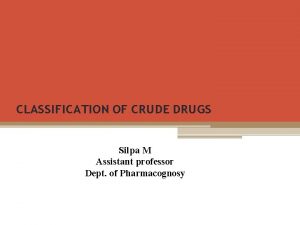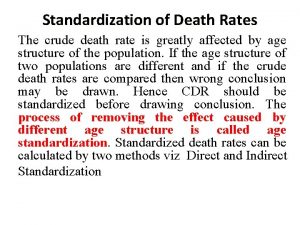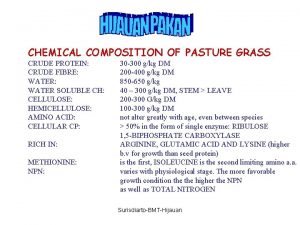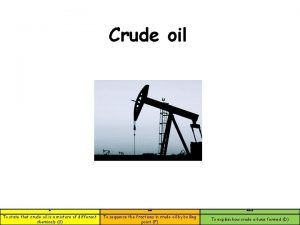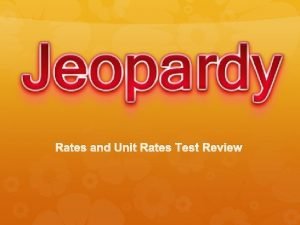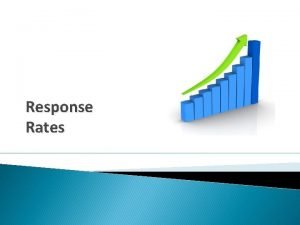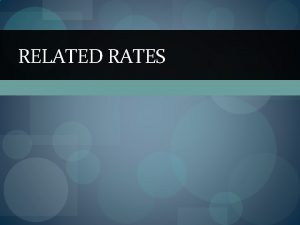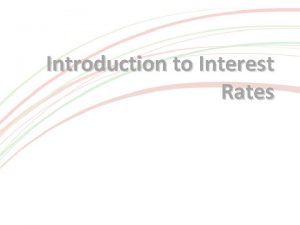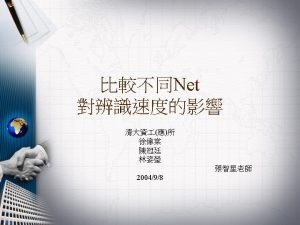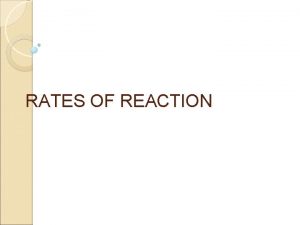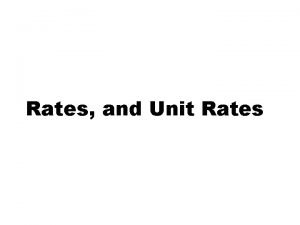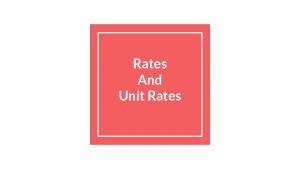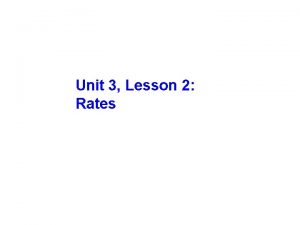Rates crude net migration rate total in total


























- Slides: 26

Rates crude: net migration rate = total in - total out/total midyear population x 1000 internal censal component method births deaths by age groups, compared to actual population migration ratio = net migration/birthsdeaths*1000

Counter-urbanizations Movement to rural areas then becomes movement to suburbs cuz what happens when the city moves out to you? Historically, suburbanization accelerates as trolley systems, then autos make it possible to be outside cities, but Fear of immigrants in cities – and fear of African Americans after the Great Migration was called “white flight” resulting in folks living in suburbs And of course, the suburban ideal, American dream, that land ownership meant wealth, home ownership was security. Moving from city to suburb is intra regional migration. (in 1950, 23% lived in suburbs; by 1998, it was 50%)

Who moves voluntarily (since these are the ones who are “selected”) young those with lots of “human capital” (education, occupation, income who have the most to gain those with less to lose by moving than by staying (sort of the opposite of human capital) other selection factors: gender, income for “amenity migrants”

Why move involuntarily? Pushes –Internationally & internally resource deterioration –drought, famine, hurricanes, flooding (Louisiana, Florida( War - Syria lack of jobs –rust belt lack of opportunity –xenophobia, prejudice, etc life cycle stage –Longino & Litwak – developmental process of aging migration– • first to retirement place, • then towards supports, • then into nursing home or place where one can be cared for.

Why move? Pulls - – Internationally & internally opportunities – the opportunities do not have to actually occur! human capital/cost benefit model: • people will migrate when benefits outweigh costs. • Benefits of migration are the present value of potential income gains from the difference in income b/n origins & destinations development tends to reduce migration costs & may increase or decrease benefits of migration

Economic & social pulls and pushes benefits may be monetary but may also be Psychic/emotional/social benefits - e. g. family, sense of place or identity benefits do not have to materialize: perception of benefit is key

International Migration Influenced especially by opportunity structures in place of origin and desired place of destination. Important processes include: Step migration (e. g. , from rural to town to city to another country); Chain migration (Pioneer migrants get established and then are followed by family and friends – This is also called family migration. )

What This Means Voluntary migration is selective, the more so if pulls are the reason for movement, less so if pushes are the reason for movement See Ravenstein’s Laws! The efficiency of the stream is greater if barriers are higher (less return migration) overtime migration streams grow, since barriers to migration decline.

1875 -1920: Source of migrants changed Southern & Eastern Europe, in 1907 # was 1, 300, 000 or 15/1000 population 1882 Chinese Exclusion Act 1891 Immigration act required medical inspection of immigrants & excluded polygamists, those suffering from disease, or convicted of moral turpitude 1892 Ellis Island

1921: Quota Act and 1924: National Origins Act pegged immigration to a percentage of the 1910 census for new immigrants from the origin then pegged immig to a % of the 1890 census for new immigrants from the origin

Great Depression, WWII, 1950 s, 1960 s, 1980 s many fewer immigrants, large proportions of return migrants Loosening of rules with Mc. Carran Walters Act (1950 s) more changes in 1964 (family reunification) amnesty rules in 1980 s - an attempt to “regain the rule of law” (& make the violation on the part of the employer, not the employees)

Does immigration do economic harm to receiving country? Evidence to date: mixed, but primarily not chain migration affects labor markets competition in the lowest wage areas of economy – but these are usually jobs not taken by other groups – even jobs that wouldn’t exist without the very cheap labor pool seems to provide economic boost in high wage, high skill parts of economy

Why it matters: US Data 15% foreign-born in 1910; only 13% today (2015). births to foreign-born women now account for 1 -in-4 births in the United States, up from about 1 -in-20 three decades ago. Pew

Primarily because of the tripling of the foreign-born population alone was estimated at 28 million, or 1 -in-10 U. S. residents, in 2000; Up to 13. 1% in 2013; - 41. 3 million in 2013 As a result of the high levels of international migration of young adults to US during 19702000, the foreign-born & 1 st-generation pop is also younger. As of 2008, net migration is negative. 25 percent of the nation's population under age 25 in 2000 was either foreign-born or 1 stgeneration, up from only percent in 1970.

More facts: Contrary to popular belief most children who live with foreign-born parents were born US – 8 in 10 born in US (why? Who moves? Young people. ) Mexico accounts for more than one-quarter of this population. A ratio of 7 -in-10 foreign-born people lived in six states More than 3 -in-10 foreign-born people lived in the Los Angeles and New York metropolitan areas alone. (then TX, IL, WA, FL

Income & Time The 2016 median income of households with a foreign-born householder ranged from a low of $49071; for US born - $51939 Median duration of residence in the United States for the foreign-born population was 25 years for those from Europe and 14 years each for those from Asia and those from Latin America.

Regions of Origin, US immigrants

Household & Education Average household size foreign-born households ranged from 3. 7 persons for those with Latin American householders to low of 2. 3 for those with householders from Canada and Europe. Among foreign-born people who were 25 or older, high-school completion rates ranged from a low of 34 percent for those from Mexico to a high of 95 percent for those from Africa. While more than 6 -in-10 householders from Europe owned their homes, just over 4 -in-10 from Latin America did (from US Bureau of the Census)

International Migration Influenced especially by opportunity structures in place of origin and desired place of destination. Important processes include: from rural to town to city to another country – e. g. step migration; pioneer migrants get established and then are followed by family and friends) – e. g. beginning of stream, Most selective at beginning, later selects on basis of draws & pushes

Theories of International Migration Theories focused on the initiation of migration patterns: Neoclassical economics – perfect knowledge & gravity models The new household economics of migration – “it’s the household, stupid” Dual labor market theory – some labor markets World systems theory – mig is natural consequence of economic globalization whereby companies operate across natl borders

Theories of the Perpetuation of Migration Theories focused on explaining flows: Network theory Institutional theory (A range of institutions benefits from international migration including capitalists and entrepreneurs who make a profit from migration, humanitarian groups (some of them with clout), and recruiters who engage in legal migration. Underground, smugglers and traffickers also make a lucrative profit from migration. Douglas Massey argued that migration would continue regardless of the restrictions imposed by host countries and that low migration rates were artificial. He also added that the abovementioned theories indicate that migration flows would be unabated and that countries of origin were not working on restricting migration; instead labour-sending countries helped perpetuate it by making it easier for their citizens to migrate. Cumulative causation - The theory of the cumulative causation of migration posits that as migratory experience grows within a sending community, the likelihood that other community members will initiate a migratory trip increases

Massey’s “Perverse Laws of International Migration” Immigration is a lot easier to start than it is to stop. Actions taken to restrict immigration often have the opposite effect. The fundamental causes of immigration may be outside the control of policy makers. Immigrants understand immigration better than politicians and academicians. Because they understand immigration better than policy makers, immigrants are often able to circumvent policies aimed at stopping them.

Contrary US Policies: Think about the 3 myths article! Limit work permits which turns otherwise legal migrants into unauthorized migrants. Maintain family preference system which encourages non-workers to migrate. Heavily patrol the border which discourages circularity—”traps” undocumented immigrants in the US and encourages them to stay.

Forced Migration: Refugees/Asylees “Solutions” to the refugee population problem: Repatriation to the country of origin. Resettlement in the country to which they initially fled. Resettlement in a third country. Internally displaced persons Slavery (including all kinds of human trafficking) Resource pushes don’t count as “refugees” for UN/US

Consequences of Migration at the individual level: Impact on migrants themselves (xenophobia, discrimination, enclaves, ethnic sorting) Types of incorporation: Adaptation Acculturation Assimilation (or segmented assimilation) Integration Exclusion Multiculturalism (pluralism) Children of immigrants face special issues

Societal Consequences of Migration Impact on receiving and sending communities Donor area typically loses young adults (which can slow down population growth in those areas). Host area gains those young adults, which can increase population growth and augment youth bulges. Remittances from migrants back to sending communities have become important to the economies of those places, and encourage continued migration.
 Crude net migration rate
Crude net migration rate Ratios rates and unit rates
Ratios rates and unit rates Proportions guided notes
Proportions guided notes Ratios rates and unit rates
Ratios rates and unit rates Ratios rates and unit rates
Ratios rates and unit rates Unalaska population pyramid
Unalaska population pyramid Cbr definition ap human geography
Cbr definition ap human geography Death rate formula
Death rate formula Rumus kematian bayi
Rumus kematian bayi Birth rate equation
Birth rate equation Immigration policies ap human geography
Immigration policies ap human geography Classic asp to asp.net migration
Classic asp to asp.net migration Cap rate interest rate relationship
Cap rate interest rate relationship Nominal v. real interest rates
Nominal v. real interest rates Plant growth index
Plant growth index Contoh transaksi forward
Contoh transaksi forward Addison currency exchange
Addison currency exchange 1 year forward rate formula
1 year forward rate formula 1 year forward rate formula
1 year forward rate formula What is the difference between rate and unit rate
What is the difference between rate and unit rate Mnemonic for crude oil fractions
Mnemonic for crude oil fractions Difference between fine touch and crude touch
Difference between fine touch and crude touch Crude touch
Crude touch Organised and unorganised drug difference
Organised and unorganised drug difference Crude steam engine
Crude steam engine What is crude oil made of
What is crude oil made of Isapagol
Isapagol
